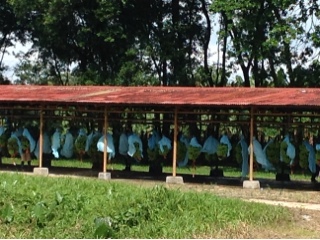Curaçao is one of the ABC Islands situated off the north coast of Venezuela. Aruba, Bonnair and Curaçao. It was part of the Netherland Antilles until 2010. Now it is still a Dutch island, but different governance.
We have studied the tour options looking for one that does NOT include the ubiquitous shopping time allotted. Alas, shopping must be the number one interest of tourists on shore excursions. This one does not have shopping and we are happy.
Our tour takes us to the impressive "Boka Tabla" rock formations along North Beach, a slave museum and a beautiful beach on the far Western end of the island. We end our tour with a drive past the salt flats where we are treated to a flock of Caribbean flamingoes.
The island is very arrid receiving less than 22" of rain a year. Cactus thrive as they did on Aruba. Farming isn't possible on a large scale as the soil is so poor-- mostly volcanic rock and coral from the early formation of the island. Most fruits and vegetables are imported as is nearly everything else they eat or use. There is no large scale manufacturing of anything on the island. Fresh water comes from a few cisterns which collect rainwater and the rest from the desalination plant.
Boca Tabla on North Beach
We then travel to the Old Labor House and Museum where we learn about life on Curaçao in the old days. Slavery was prominent on the island in colonial days and wasn't totally abolished until 1863. The slaves were needed for the intensive work to grow crops of peas, beans and a few, other edibles.
Totally refurbished slave quarters.
Definitely out door toilet behind cactus fence.










































